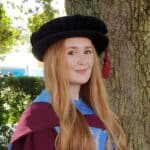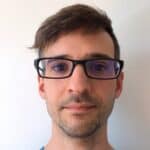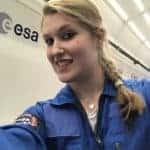Profile
Pierre Lasorak
-
About Me:
I live in Oxford with my son and my wife. I work as a particle physicist in London. I like running, mountaineering, skiing, trekking and doing DIY.
-
My pronouns are:
he/him
-
My Work:
I am a research student at Imperial College, London; my research is about neutrinos.
-
Read more
I study neutrinos. They are fundamental particles that are everywhere around us, but we cannot see them. They exist in 3 variations (electron neutrinos, muon neutrinos, and tau neutrinos). You can also have anti-neutrinos (electron anti-neutrino, and so on).
Over the course of 1 second, you have 70 billions neutrinos that cross every square cm every second on Earth. These neutrinos come from the Sun, and they also reach us at night, this means most of them have crossed the Earth without interacting!
Beyond the Sun, there are other sources of neutrinos, for example, nuclear reactors create them, cosmic rays interacting the atmosphere too, and also particle accelerators. My research is focused on the latest. I work on an experiment called DUNE (Deep Underground Neutrino Experiment) which is based in the USA. It will use a large proton accelerator next to Chicago to create a very intense neutrino beam, which we direct into the ground. The neutrinos then come out in South Dakota, 1,500 km away, where we put a very large detector inside a mine to detect them.
We are interested in measuring a phenomenon called “neutrino oscillations”. This happens when neutrinos change flavour as it travels. So, in our case, our proton accelerator will create a lot of muon neutrinos, but when they will come out in South Dakota, most of them have turned into tau neutrinos and some of them in electron neutrinos. We will measure what exact proportion of them have changed, and we will do it for neutrinos and anti-neutrinos. That way, we can see if there are differences between neutrinos and anti-neutrinos.
Why would we do all that? That’s because it’s very difficult in particle physics to have processes where matter and anti-matter behaves differently. But we are all made of matter, so sometime, just after the Big Bang, there must have been some processes which created an imbalance, tilting the content of the universe so that matter becomes much more abundant than anti-matter. Neutrino oscillations could be one of these processes.
-
My Typical Day:
I spend a lot of time behind a computer screen doing coding. I have meetings most of the day, where I discuss what needs to be done and how with my peers. Sometimes, I get to teach labs to undergrad students (which is quite fun). I also supervise a PhD, so I spend some time discussing with him about his research.
-
Read more
I work from home a lot, so sometimes, I just get up give breakfast to my son, have breakfast myself, and sit at my desk. Other times, when I go to London, I jump on the train with my folding bicycle. Once I’m at my desk, I try to see if there is something that requires my immediate attention: I work with a lot of people collaboratively, and it happens sometimes (rarely!) that one of the change that I made (or someone else) the day before breaks the software for everyone, it’s not a situation we want to be in! Once I have done that, and eventually fixed things, I think about the work that needs to be done during the day and start working on it. For example, if I have to include a new functionality on the software that I am working on, I get on with it. I then touch base with the my student, maybe once every 2 days, ask him how he’s doing and if he needs help. I touch base with people I work with (do they need help). After lunch, USA wakes up, so it’s generally time for meetings with my colleagues in the USA. We discuss about what needs to be done, what we should prioritise next etc. After that one or 2 more hours of coding, and then I jump on a train back to Oxford!
-
Education:
Masters at INSA (Lyon, France) 2008-2013
I did my masters there. I studied engineering and material sciences, so for example how to make and process plastic, how iron is cast, how silicon chips work. It took 5 years in total, but I got to go to Spain in my very first year (a place called Castellón de la Plana), where I learnt Spanish. For my final year, I spent it in India (New Delhi). Also Lyon was very nice.
Masters at UJF (Grenoble, France) 2013-2014
After my masters at INSA, I decided that I didn’t really want to work as an engineer, and wanted to do “fundamental physics”. So I did another masters for a year in Grenoble. I spend 6 months there and then came to the UK for a my project for the rest. It was very difficult to join a particle physics masters in the second year, I didn’t get very good grades.
Doctorate at Queen Mary, University of London (UK) 2014-2018
After my masters, having studied all particles, I joined a research group in Queen Mary University. There I worked on an experiment called T2K (Tokai to Kamioka), in Japan. T2K studies neutrino oscillations. It took me 3.5 years to finish my PhD. It’s probably one of the hardest things I have done in my life, I really liked studying neutrinos, but I was happy when it was over.
-
Work History:
Internships and summerwork
During my studies, I work in different places:
- Sawmill in Scotland for a Summer.
- Silicon chip factory next to Grenoble for a Summer (after which I bought my first guitar from my wages!).
- A start up company in Silicon Valley that was trying to do high efficiency solar cells with a complicated process.
Postdoc at Sussex University (2018-2021)
For my first postdoc, I worked in Brighton at Sussex University. I join DUNE: Deep Underground Neutrino Experiment. I was working on detecting Supernova burst neutrino on DUNE. Basically when a star explodes it emits a lot of light, but also a lot of neutrino. If we are lucky, we can detect some in our detector. So I was working on a system called the “trigger”, that tries to understand when the detector should start recording the supernova neutrinos.
At Sussex, I also worked on NOvA: NuMI Off-axis electron neutrino Appearance (and NuMI stands for Neutrino Main Injector… We like making acronyms complicated….). At first I was working on the joint NOvA-T2K analysis (an combined analysis with all NOvA and T2K data together), but I quickly moved to doing a NOvA only analysis. That analysis was a lot of work! I measured the neutrino oscillations.
-
Current Job:
Postdoc at Imperial College London (2021-present)
I work as a postdoc at Imperial College London. I am still working on DUNE. I am in charge of the “run control”, which is the system with which user start recording data from the experiment. Basically it will look like a website where one can press “record” and the detector start creating files with the data! Except the files will be very big (6 GB), and if the nothing is happening in the detector, the recording pauses.
I also work on LiquidO, which is a new detector technology. I am making pictures of how neutrinos look like inside LiquidO.
-
Employer:
Imperial College, London
-
My Interview
-
How would you describe yourself in 3 words?
curious postdoc father
What did you want to be after you left school?
I wanted to be engineer (I think)
Were you ever in trouble at school?
Not so much. I hated going to swimming classes (although I did know how to swim well)
If you weren't doing this job, what would you choose instead?
A data scientist job, trying to make sense of the data around us. Maybe I could also have a book shop and spend my day reading.
Who is your favourite singer or band?
Radiohead (of course, I live in Oxford!)
What's your favourite food?
I like Indian street food a lot (bhel puri, chaat, pakoras, samosas)
If you had 3 wishes for yourself what would they be? - be honest!
Hike up the Mont Blanc. Go to South pole. Go to Iceland.
Tell us a joke.
And God said, “Let there be light,” and there was neutrinos.
-





